Cooking with Franz Kafka

Photograph by Erica Maclean.
In Franz Kafka’s first published story, “Description of a Struggle,” the narrator is sitting in a drawing room at a rickety little table, eating a piece of fruitcake that “did not taste very good,” when a man walks up to him. The man is described as an “acquaintance,” but we soon realize he is a double, or another part of the narrator’s self. The acquaintance has fallen in love and wants to boast about it. “If you weren’t in such a state,” he scolds, “[you] would know how improper it is to talk about an amorous girl to a man sitting alone drinking schnapps.” The comment seems to threaten an unchecked appetite. What would the lonely, schnapps-drinking man do if tempted by the girl? The struggle that follows, metaphorically speaking, is between the sides of the protagonist’s character—on one side, the man who desires to stand apart from society and guard his creative self, and on the other, he who wishes to fit in and reap the pleasures of fruitcake and amorous girls.
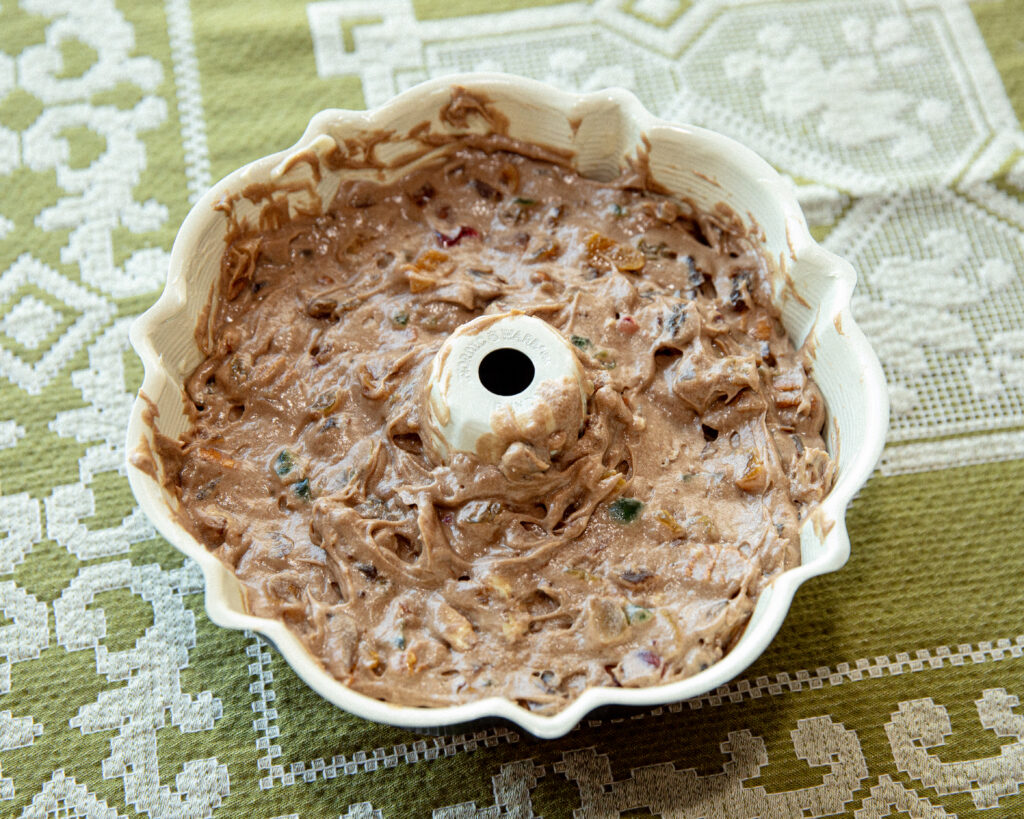
Photograph by Erica Maclean. Fruitcake batter, from Kafka’s “Description of a Struggle.” The protagonist consumes it sitting at a tiny table with “three curved, thin legs … sipping my third glass of benedictine.”
The tension in Kafka between appetite and its fulfillment is a crucial aspect of the writer’s work. Kafka’s characters are often hungry—the performer from “A Hunger Artist” has made starving himself into an art; Gregor Samsa from The Metamorphosis slowly stops eating and wastes away. But their hunger is often not for the foods of this world. Gregor refers to himself as hungering as for “an unknown nourishment.” The hunger artist’s last words are a confession that fasting was not difficult for him because, he says, “I couldn’t find the food I liked. If I had found it, believe me, I should have made no fuss and stuffed myself like you or anyone else.” Instead the characters seek the deeper forms of sustenance—emotional, societal, sexual, spiritual—and don’t find them.
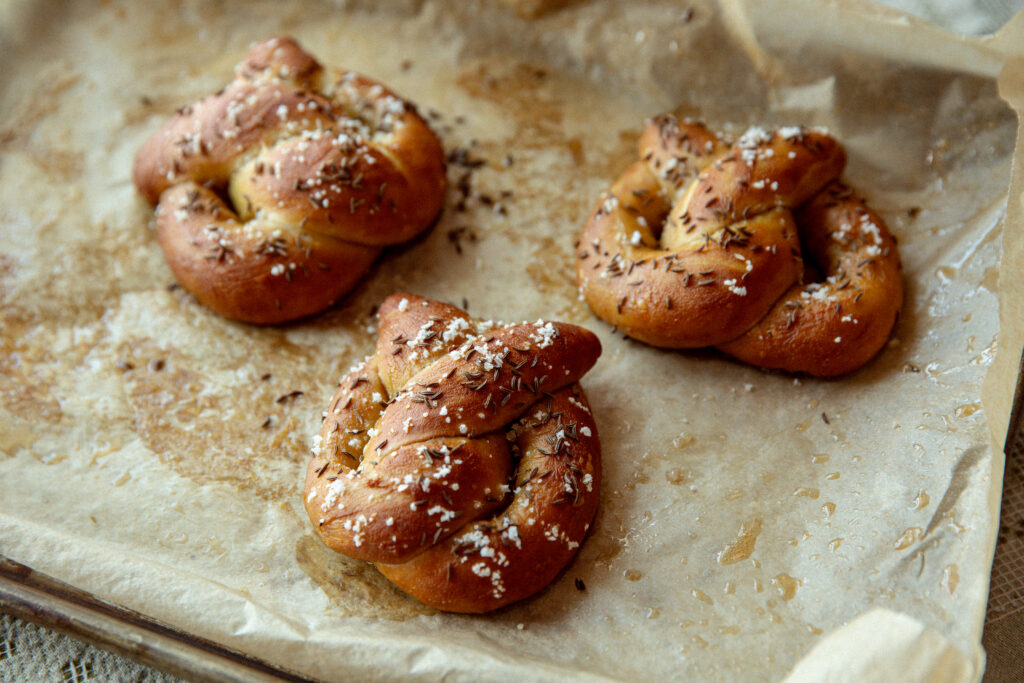
Pretzels like these, crusted with salt and caraway seeds, are a reward of belonging to the power structure in Kafka’s The Castle.
The authors of the book Kafka: A Manga Adaptation agree on the centrality of hunger to Kafka’s work. The Japanese brother-and-sister duo Nishioka Kyōdai chose it as the unifying theme for their collection, along with what they call “power and economics.” The book was published last November by Pushkin Press, in a translation by David Yang, and its flat, emaciated characters, with their blank faces and all-black button eyes, display the condition of people in Kafka’s world, starving for something good. But why, and what? It’s the manga artists’ view that the food on the page is telling, and they often devote full panels to it. Despite Kafka’s extremely unappetizing imagination, food appears regularly in his stories and novels—and looking at it, and cooking it, might tell us something about what the characters really hunger for.
In The Metamorphosis, the food is controlled by Gregor’s family. His father, mother, and beautiful young sister, Grete, spend most of the story seated at a table outside Gregor’s room, eating. Gregor, in his grotesque new form, is not allowed at the table. Yet he finds himself on the morning of his transformation to be “much hungrier than usual.” Terrible as his metamorphosis is, it frees him from work and from being useful to his family, suggesting that he is showing a more authentic self. Incidentally, Kafka in his lifetime refused to specify what kind of creature Gregor was and forbade any drawing or representation of him. The Nishioka manga respects this and depicts the story from Gregor’s perspective without ever drawing his body. This absence opens the realm of possibility—we don’t know what Gregor’s transformation truly means, only how it is perceived by himself and others. An unknown winged creature longing for an unknown nourishment could be anything, including an angel.
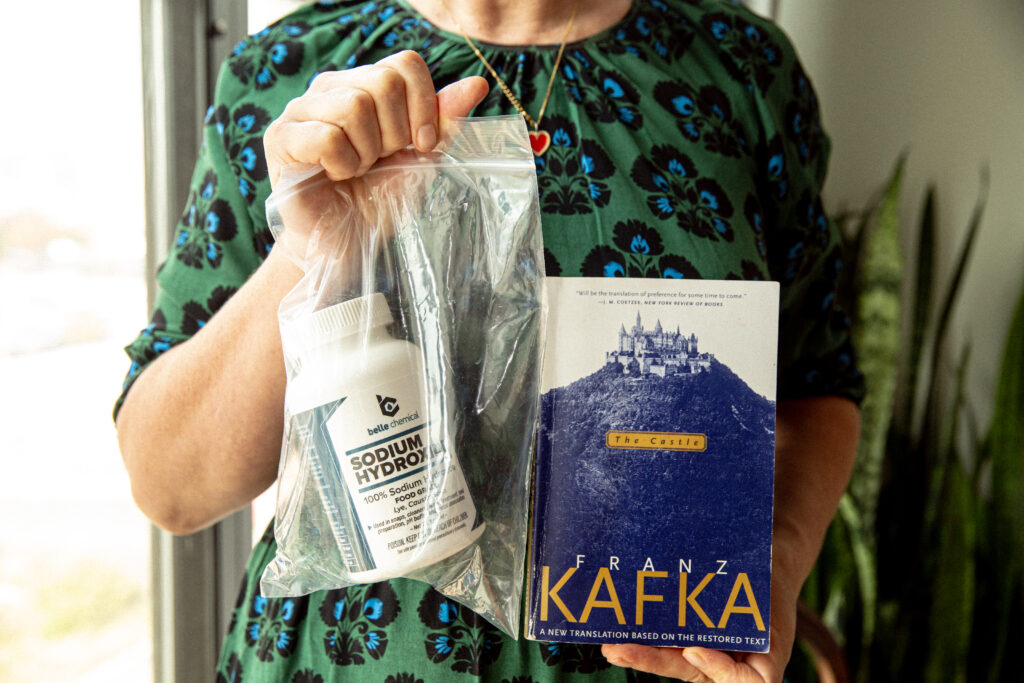
Photograph by Erica Maclean. Food-grade lye, a caustic ingredient necessary to make the crunchy pretzels from The Castle.
The Metamorphosis contains many indelible food scenes, including an early one when Gregor’s sister, Grete, who at first seems like she might be able to relate to him in his new form, brings him an assortment of dishes to try. He can’t manage the “dish filled with sweetened milk with little pieces of white bread floating in it” that was a favorite treat before, but he is drawn instead to an assortment of grotesque and rotten foods. He finds himself “sucking greedily” at cheese he’d “declared inedible two days before” and then quickly, “one after another, his eyes watering with pleasure,” consuming the rest.
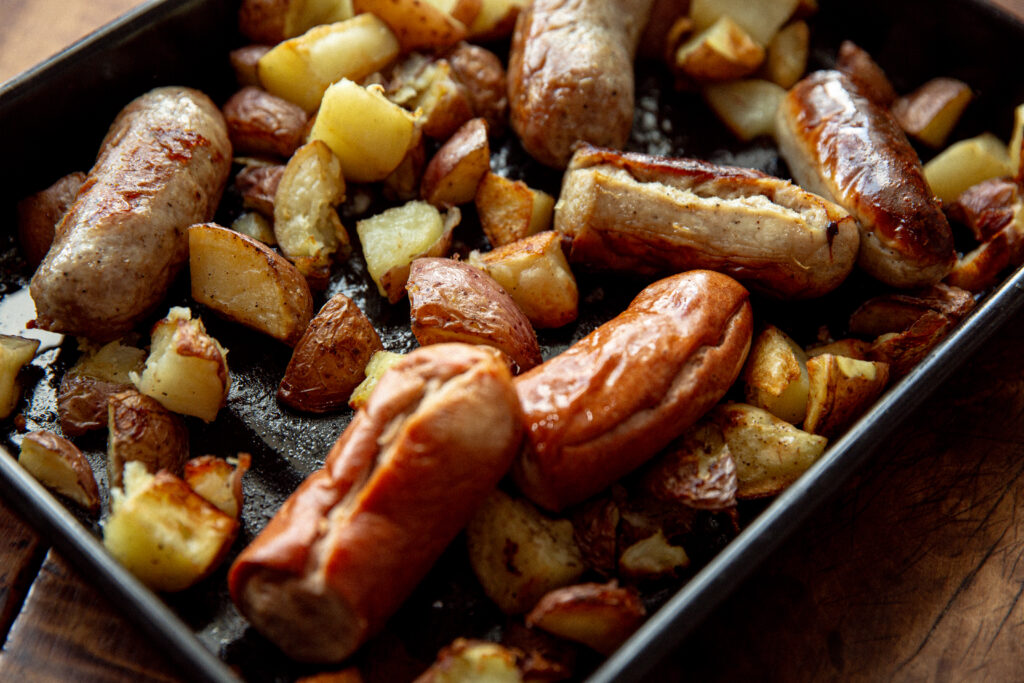
Photograph by Erica Maclean. In The Metamorphosis, the family’s lodgers are fussy eaters and take a critical attitude toward the meat-and-potatoes dinners they are served.
This promising avenue, however, is choked off by his sister’s increasing disinterest in him and by his family’s wholesale rejection of his new self. Later, when he tries to leave his room, his father throws apples at him. Kafka writes that “the little, red apples rolled about on the floor, knocking into each other as if they had electric motors.” This weaponized and surreally mechanized food does Gregor terrible damage. One apple sinks into his shell and leaves him “in a complete derangement of all his senses.” The Nishioka manga spends a page on the apples alone, depicting them on a wood floor whose hand-drawn grain has a creepily uniform and unnatural appearance that is also suggestive of the machine-made.
Kafka’s connection between work and technology as the forces promoting our alienation and misery seems prescient. The machine-apple is a minor note in The Metamorphosis, but we see machines everywhere in the writer’s oeuvre, from the torture machine of “In the Penal Colony” (which also serves food!), to the bureaucracy on display in The Castle. Bureaucracy itself, in this novel, can be seen as a kind of metamachine for work, and the castle’s functioning is eerily similar to that of the modern corporation.
Moreover, the structure of The Metamorphosis suggests an absent ideal, wherein Gregor could be his authentic self—perhaps doing meaningful work—and also be included in the social order and at the family table. The Castle suggests something similar. Its hero, K., flounders in endless, abstract application to work for the invisible powers that run the mysterious castle. Getting such work will also allow him to settle in the village outside its gates and lead a family life. However, K. constantly sabotages his own efforts. When he gets a taste of a forbidden fruit, like the cognac he steals from a castle official’s sleigh, he barely partakes of it and lets it dribble away.
One element of the brilliance and ongoing power of Kafka’s work is the intensely packed and folded layers of its symbolism. No symbol is ever just one thing; the fruitcake of “Description of a Struggle” is a lure to taste the fruits of corruption; the apple in the sophisticated later work is both fruit of the family’s participation in the machine and a placeholder suggesting the absent nourishment that Gregor longs for. I wondered what would happen if I made these foods—would they be doubly delicious, both alluring and sustaining, or as grotesque as the rotten food spread and as absent of flavor as the fruitcake?

I chose to make the sausage and potatoes served to the lodgers in The Metamorphosis, depicted in a panel of the Nishioka manga being carried by Gregor’s mother and Grete in faceless and stylized lockstep, surrounded by more sinister wood grain. This was the food of exclusion, served to three men who have disturbed the family home and taken Gregor’s place. I made a German apple cake, also from The Metamorphosis, with the apples visibly embedded, as they were in Gregor’s shell. Other snacks were caraway seed–encrusted pretzels crunched by an official in The Castle—a symbol of power and its tasty reward. And lastly, of course, I made a fruitcake.
Rarely have the results of any cooking experiment been so definitive. I did quite a bit of experimentation—there just aren’t perfect recipes for old-fashioned, technique-driven things like fruitcake and pretzels on the internet. But post-experimenting, with refined recipes, I produced classic, simple foods that were almost unbelievably good. For my meat and potatoes dish, I used high-quality sausages of a few varieties, including some from a Polish butcher near my house in Brooklyn, and I bought a biodynamic sauerkraut from a health food store to mix with the roasted potatoes. A sheet pan plus oil, salt, and pepper makes this one of the most delicious three-ingredient meals on earth. My apple cake was also simple but outstanding. Most cakes require a painstaking emulsion of liquids in order not to break the batter. For this one, the recipe instructed me to mix all the dry ingredients together with the softened butter, making a batter that was more like cookie dough, and pat it into a tart pan with the bottom of a glass before arranging the apples on top. The tender, pillowy results made me wonder why anyone makes cake in any other way. And the flavor was mysteriously ambrosial—various tasters guessed honey, almond, or marzipan—despite my using nothing more than the most standard flour-butter-sugar mixture.

Photograph by Erica Maclean. “No-one dared to remove the apple lodged in Gregor’s flesh, so it remained there as a visible reminder of his injury.”
The pretzels and the fruitcake were not simple but were even more satisfying. Pretzels are made from yeast dough, which is tricky to time, and they aren’t easy to roll out and shape without some experience. Once the pretzels are shaped, the authentic kind are dipped in a bath of a food-grade lye solution that gives them their leathery brown skin and flavor. They’re then sprinkled with toppings and painstakingly dried out in the oven. My recipe below is the culmination of much trial and error, but once perfected, my pretzels were addictively salty and crunchy and gave me a bizarre food high. Pretzels, in the modern world, are underrated.
There are no happy endings in Kafka—you can have either your soul or the fruitcake. In one of the several fragmented sections in “Description of a Struggle,” titled “Proof That It’s Impossible to Live” one character tells another that “one day everyone wanting to live will look like me—cut out of tissue paper, like silhouettes, as you pointed out—and when they walk they will be heard to rustle.” I’m not sure this is true of us; there is a stubborn animality to us that persists, despite our new technologies. But it is true of our things, evermore shoddy and false and disconnected. Take my fruitcake. The internet is full of fruitcake recipes. I tried several and never found one that made a cake you’d want a second piece of. So then I went offline, making elements myself, such as candied fruit peel, and choosing the fruit and nut assortment based not on a recipe but on what I could find that was made in the smallest batches and least industrially. The dried fruit, I thought, should be tart, boozy, and pretty; the nuts should be rich and fresh, and the batter should be just enough to hold it together. Working in this vein, after many tries, I made a wildly good cake that I personally couldn’t stop eating. In my book, if not in Kafka’s, it was not absent goodness but goodness itself.
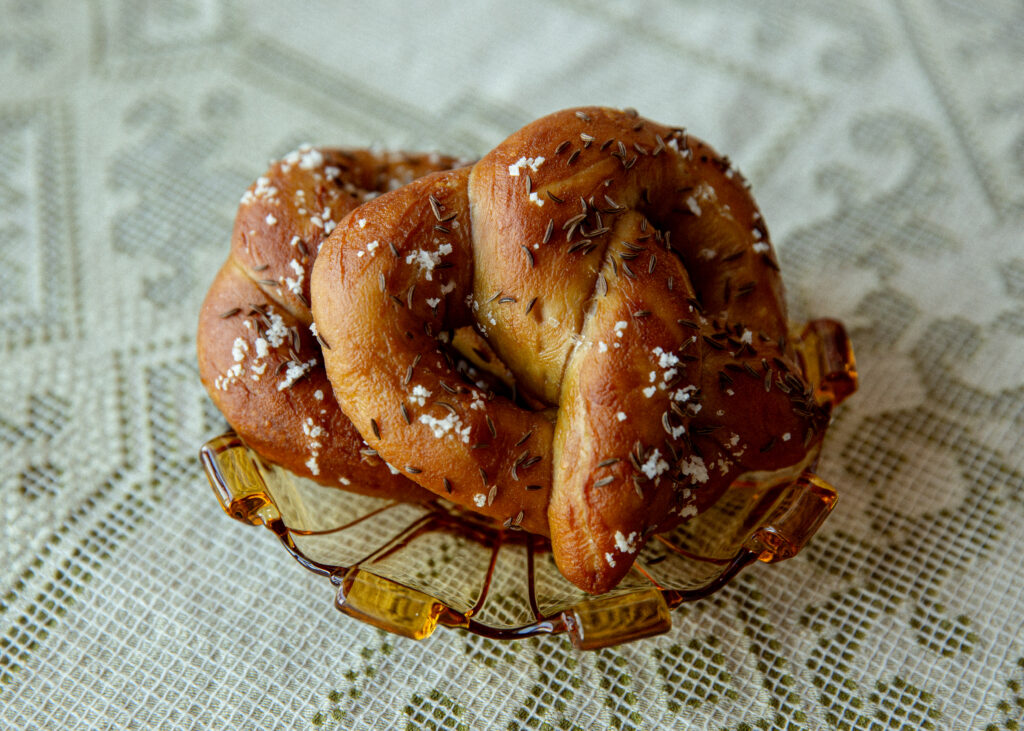
Pretzels with Caraway Seeds
For the dough:
1 cup plus 2 tbsp warm water, 110 to 115°F
2 tsp light brown sugar, divided
1 1/4 tsp active dry yeast
1 1/2 cups white flour
1 1/2 cups bread flour
1/2 tsp salt
For the lye bath:
4 cups water, room temperature
2 tbsp food-grade lye
For the topping:
2 tbsp coarse sea salt
1 tbsp caraway seeds
In a small bowl, combine 1/4 cup warm water and 1/2 teaspoon brown sugar. Add yeast and stir to dissolve. Let sit five minutes until yeast is foamy. (If it doesn’t puff up, discard and use different yeast.) Once the yeast is proofed, in the large bowl of a stand mixer, stir in the remaining 1 1/2 teaspoon brown sugar, both flours, and salt. Add the yeast mixture and 3/4 cup warm water. The dough should be soft and pliable. If it seems too stiff, add more water and knead using the dough hook attachment for five minutes, until the dough is smooth and elastic. Place in a lightly oiled bowl, covered, and set inside your microwave with the door slightly ajar so the light stays on. (This mimics a proofing box and is a trick for raising bread in colder climates. If you’re in a warm climate, the countertop is fine.)
While the dough is rising, which can happen in less than forty-five minutes, prepare the lye bath. Lye is a caustic substance and could damage your skin and eyes, and there are many warnings and safety guidelines available on the internet about working with it; I recommend these. It’s essential that you use food-grade lye, available on Amazon, which makes the pretzel’s hard, blistered skin. Lye is also corrosive to containers, so you want a nonreactive plastic container for the following step. Tupperware-style plastic containers say which kind of plastic they are on the bottom, and you want number two plastic (HDPE, or high-density polyethylene) or number five plastic (PP, or polypropylene). Taking all relevant safety precautions, fill the container with water, add the lye, and use a silicone spatula to stir to dissolve.
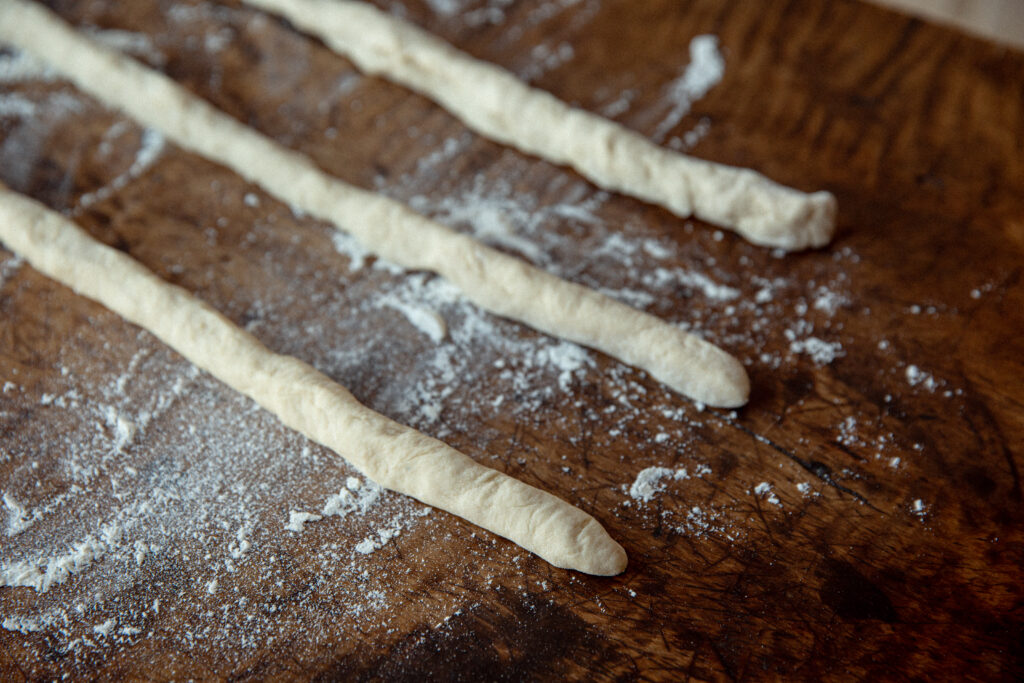
Prepare to shape and bake. Set out a baking sheet lined with parchment paper and butter it liberally, otherwise the lye-dipped pretzels will stick to the paper. Preheat the oven to 325°F. Set a small bowl of water on the countertop where you’ll roll out the pretzels. Combine the salt and caraway seeds for the topping. When the dough has doubled in size, cut it in quarters, then shape each quarter into an even log, knocking out as little air as possible. Cut each log into fifths. Cover the unused dough with a damp towel and prepare to roll out and shape. The objective is twenty long, thin rolled strands of about fifteen to eighteen inches each. However, the rolling can be challenging since the dough quickly gets stiff and overworked. Starting with your thumbs in the center of the ball, quickly and smoothly press down while rolling the dough back and forth on the countertop. (I didn’t need to flour my workspace, but it might depend on your dough.) You want to coax the dough into shape before it loses too much air. No pinching, pressing, or pre-shaping, or it will become hard to work with. As the dough strand lengthens, flatten your hands until you’re using both palms to roll, and you can really apply a lot of pressure. If the dough becomes too tough and springy, set it aside for five minutes to rest.
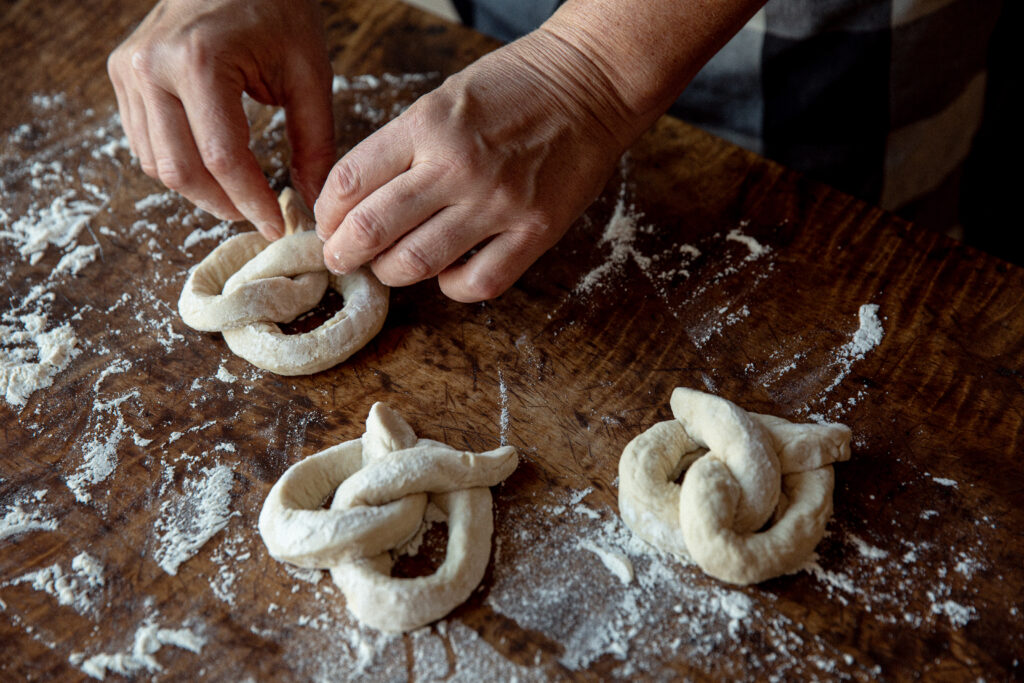
When the dough strand has reached the desired length, twist it into shape. There’s a good tutorial on shaping with photos available here. In brief: Take a rope of dough and make a U shape. Cross the arms over once, then cross again in the same direction to make the twist. Then bring the arms down to the belly of the U, dab each one on the underside with a little bit of water, and press them firmly to create the pretzel shape. Cover and let rise again for twenty minutes. Then uncover and let sit for fifteen more minutes to form a skin. Ideally, at this point you’d freeze the dough for at least twenty minutes to make it easier to work with during the dipping process, but I ran out of time, and it was fine.

When the pretzels are ready, dip each one into the lye bath for thirty seconds, using a slotted spoon or tongs, then place the pretzel on the greased parchment. When all pretzels are dipped, sprinkle with the topping. Bake for twenty-five minutes, then rotate the pan and bake for forty minutes more. (The steam created during baking will neutralize the lye and make the pretzels safe to handle and eat.) The timing is less important than getting the dough completely dry and crisp. You can determine doneness by tapping the pretzel with your finger or by sacrificing a pretzel to test and breaking it. If they’re browning too quickly but aren’t yet crisp, remove them from the oven and allow them to cool while reducing the oven temperature to 300°F. Return to the oven and bake ten more minutes and check. If still not done, continue baking, checking every five minutes until crisp.

Sausage and Potatoes
3 sausages, German style, cooked or uncooked
4–5 large white potatoes, peeled and cubed
Olive oil
Salt and pepper
1 cup sauerkraut
Preheat the oven to 400°F. Arrange the potatoes on a sheet pan, drizzle generously with olive oil, season with salt and pepper, and toss with your hands to combine. Arrange the sausages on top of the potatoes and bake, uncovered, thirty minutes, tossing occasionally, until the sausages are cooked through and the potatoes are crispy and browned. If your mixture includes cooked sausage, it will puff up and burst, but that’s fine. Five minutes before the end of the bake time, add the sauerkraut to the tray and toss to combine. Serve warm.
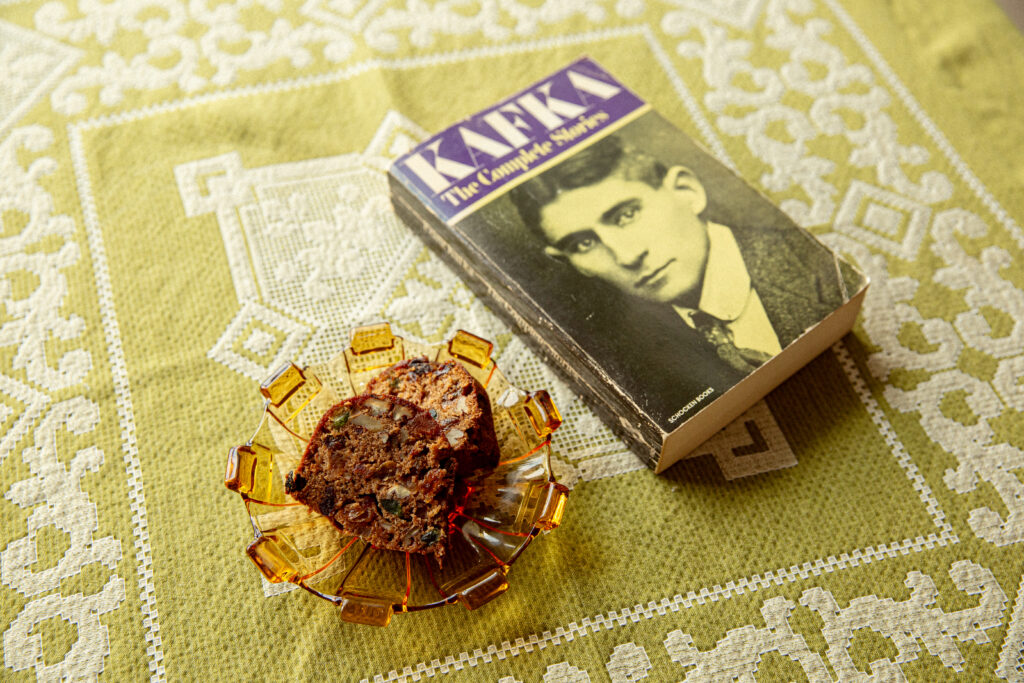
Fruitcake
Fruitcakes are better with age, and many of the ingredients suggested here are better made over the course of several days. Start at least two weeks ahead of the time you wish to serve or gift your cake.
For the fruit and nuts:
2 cups high-quality* mixed dried fruit: apricots, large golden raisins, dried pineapple, red and green candied cherries
2 cups rum
3/4 cup soft, chewy Medjool dates, chopped
1/4 cup mixed candied peel, chopped (use only if homemade, otherwise substitute crystallized ginger)
1 1/2 cups chopped nuts (recommend a mixture of pecans and pistachios)
*NOTE: The key to a delicious fruitcake is delicious dried fruit. You’re looking for a combination of tart, sweet, juicy, and pretty in your fruit choices. The types of fruit you use matter less than choosing fruits that will look and taste the best.
For the batter:
1 stick butter, room temperature
1 cup dark brown sugar, packed
1/2 tsp salt
3/4 tsp cinnamon
1/8 tsp allspice
1/8 tsp nutmeg
1/2 tsp baking powder
2 eggs, room temperature
1/4 cup golden syrup
1 tbsp cocoa powder
1 1/2 cups flour
2 tbsp water
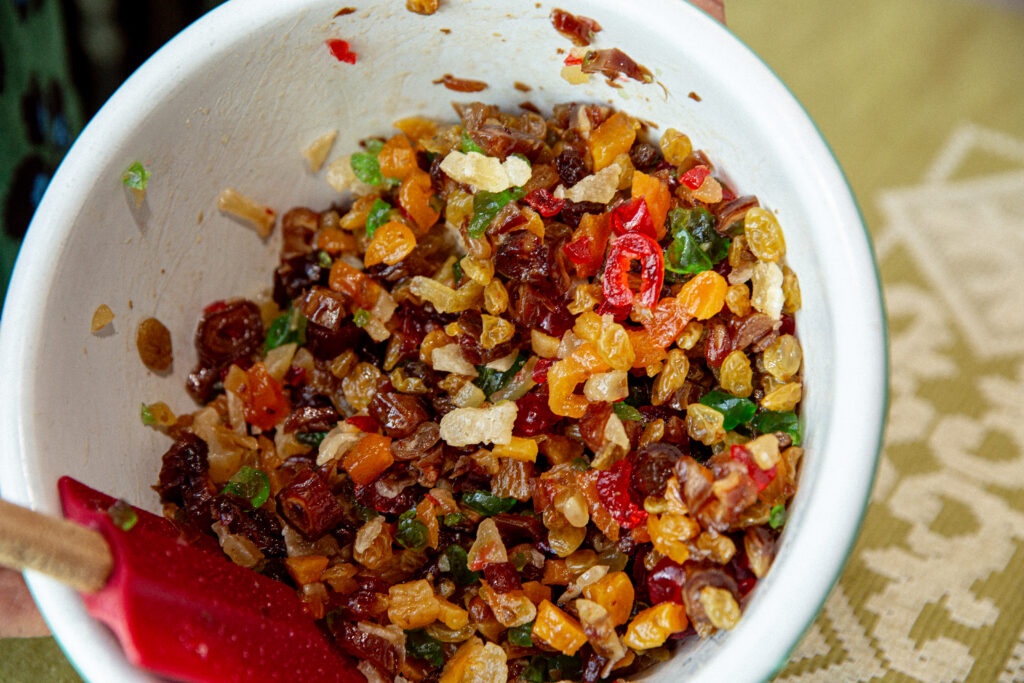
Chop the apricots or other larger dried fruits in your two cups of fruit mixture. (I like to leave the colorful candied cherries whole for visual appeal.) Place the mixture in a covered, nonreactive bowl and cover with the two cups of rum. You want the fruit to be fully submerged. Cover and let sit for eight hours or overnight or even longer. (You are not soaking the dates or the candied peel.)
When it’s time to assemble the cake, preheat the oven to 300°F. Grease a nine-by-four-inch loaf pan. Place the butter and brown sugar in the bowl of your stand mixer and whip until fluffy and well-combined. Add salt, spices, and baking powder and whip to combine. Add the eggs, one at a time, scraping down the bowl between each addition, followed by the golden syrup. Add the cocoa powder and flour and stir until just combined. Add the water, the dates, the nuts, and two cups of the fruit mixture, scooped out of the liquid but not drained, and stir until combined. (The fruit will swell up with soaking, so you may have more than two cups. Reserve for another use.) Spoon the batter into the pan and bake for forty-five to seventy-five minutes, until a tester entered into the cake comes out clean. Eat immediately.

German Apple Cake
Adapted from Bon Appetit.
1 stick butter, cut into pieces, room temperature, plus more for greasing the pan
1/4 cup breadcrumbs
2/3 cup sugar
1 tbsp lemon zest
1 tsp baking powder
1 tsp salt
1 cup flour
1 egg, fork-whisked
1 tsp vanilla
3 medium, firm, tart apples, such as Granny Smith
Preheat the oven to 350°F. Butter a nine-inch loose-bottom tart pan and dust with breadcrumbs, tapping out the excess. Whisk the sugar, lemon zest, baking powder, salt, and flour together in a large bowl. Then make a well in the middle and add the egg, vanilla, and butter. Stir until the dough comes together in large clumps, then knead gently with your hands until it comes together in a mass. Flour your hands a little if the dough is too sticky.

Gently press the dough into the prepared pan, flattening with the bottom of a glass or measuring cup and using more flour if it sticks. Peel, quarter, and core the apples. Place them cut side down on a cutting board and make thin, parallel crosswise slices in each quarter, taking care not to cut all the way through, so the apples stay in one shingled piece. Arrange the apples in concentric circles over the entire surface of the dough, trimming to fit if necessary (you may have some extra pieces). Bake forty-five to fifty-five minutes, until the apples and crust are golden in color. Check after thirty minutes to make sure the cake is not browning too quickly; if it is, cover with a piece of tinfoil. Cool and serve.
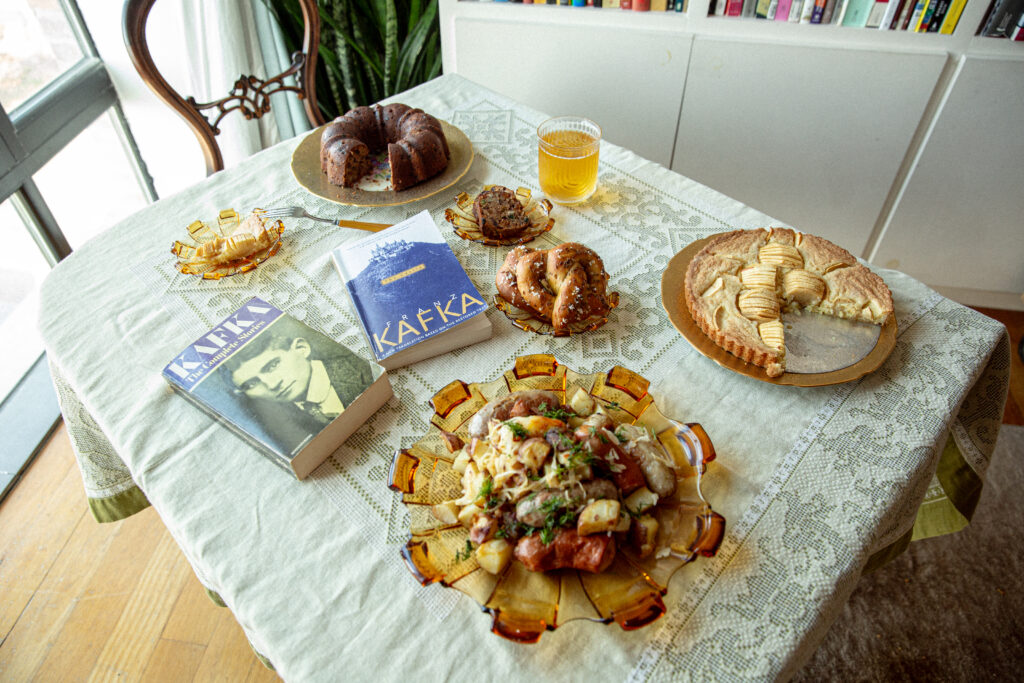
Valerie Stivers is a writer based in New York. Read earlier installments of Eat Your Words.
